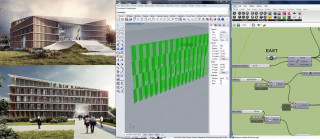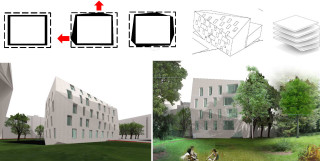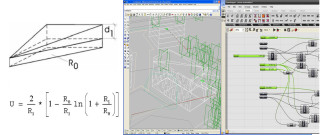what does Passive House do for architecture?
How A2M architects, in the context of the explosion of PassiveHouse projects in the Brussels Region, developed a new architectural design narrative. Contemporary tools as parametric design software enable the architect to reconsider the physical composition of the environment as an integral part of the project design process.
A2M is an architectural agency which only designs PassiveHouse projects, including renovation. Over the past few years, we started integrating environmental analysis as part of our practice.
In this Brussels context, we are discovering new paths within the architectural narrative. The question of loss of meaning in architecture has been dogging the sector for nearly fifteen years. Could what the passive dimension entails today, be similar to the impact concrete had on the architectural language developed by the modernist movement?
Recent research by Philippe Rahm and Sean Lally shows a project design method based, amongst others, on the induced heat exchanges as support for the functions. They propose, instead of the classic use of architectural envelope as “mediation”, to design our “active context” as architecture.
Similarly to the classic Greek order of composition, we can use air flow, heat transfer, solar radiation, etc. as a new “order” of composition.
Glass allowed for transparency, and « generated » the R. Neutra houses, concrete allowed for malleability, and “generated” the E. Saarinen terminal in JFK airport. The question now is: how can we develop a new architecture which could have a positive impact on the environment, whilst also being shaped by environmental analysis (daylight analysis, thermal exposure studies, airflow, etc). These simulations provide new information thanks to digital aided design and become new tools for the development of a space syntax .
Towards a new way of design
A2M recently started using parametric design software. As such, the algorithmic games becomes a tangible design tool “refeeding” our architectural narrative.
In the project for the Belgian/Netherlands Embassy in Kinshasa (DRC), under construction and which achieved both PassiveHouse and BREEAM excellent in a tropical context, we used the Grasshopper algorithms in the Rhino modeler crossed with Ecotect, so as to optimize the parametric composition of the envelope. We set some basic rules and “meta-rules“, which then generated the solar radiation associated with approximately 200 different solar blind orientations. The most optimized ones where selected.

The Belgian/Netherlands Embassy in Kinshasa (DRC) and Grasshopper screen capture showing the sun blinds generated

The 200 solar radiation results
In the project « City blocks to City Rocks”, a multi-residential project, the skin thickness is generated by modifying the insulation thickness which sculpts the building as a whole.

In order to define the U variable thickness, we used the EN 6946 AnnexC.

The EN 6946 AnnexC and Grasshopper screen capture showing the project with variable insulation thickness generation
In the case of this project, there were too many volumes and we wanted to be able to “play” with the global shape and have the result in real time. This is only possible using the Grasshopper algorithms in the Rhino modeler.
Architectural quality ?
Although the passive character of a structure is no guarantee in itself of its architectural quality, disregarding it is no easy matter nowadays. Architectural quality cannot ignore the treatment of the envelope and the environment it generates.
Contemporary tools enable the architect to reconsider the physical composition of the environment as an integral part of the project design process.
Whereas the projects presented here are still in the embryonic stage of experimentation with these new realities, there is reason to believe that many future projects will fully integrate the upheavals we have been plunged into. It will then become absurd to separate architecture from energy …
The question therefore is no longer “what is the passive standard doing to architecture?” but becomes “how can the passive standard be used to give meaning to architecture?”
References
PassReg: www.passreg.eu
Rahm Philippe, 2009, “Architecture météorologique”, Crossborder, Archibook.
Lally Sean, 2014 , “The Air from Other Planets, A Brief History of Architecture to Come”, Lars Müller Publishers.
Aananaz Abdennour, Branders Aline, De Meester Bram, Deprez Bernard, Desmet Stéphane, Devroey Daniel, Di Pietrantonio Marny, Leribaux Sabine, Loumaye Frédéric, Meersseman Benoit, Moreno-vacca Sebastian, Willem Julie, 2014 ,“Passive Architecture”, A2M publisher, Brussels.